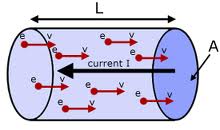Drift velocity facts for kids
Drift velocity is the average velocity with which free particles, for example electrons, are pulled towards an electric field.
Contents
Drift Velocity
Drift velocity is a fascinating idea in physics! It describes the average speed that tiny charged particles, like electrons, move in a specific direction when an electric force acts on them. Think of it like a very slow, steady flow of water in a river, even if the individual water molecules are zipping around randomly.
What is Drift Velocity?
When you turn on a light switch, electricity flows almost instantly. But the individual electrons don't actually zoom through the wires at the speed of light. Instead, they move quite slowly! Drift velocity is the average speed these electrons gain in a particular direction because of an electric field. This field is like an invisible push that guides them.
Electrons in a Wire
Inside a metal wire, there are billions of "free" electrons. These electrons are not stuck to any single atom; they can move around. When you connect a wire to a battery, the battery creates an electric field inside the wire. This field pushes the free electrons. Even though they bump into atoms and other electrons all the time, they slowly drift in one main direction. This slow, steady drift is what we call drift velocity.
Drift vs. Random Motion
It's important to know that drift velocity is different from the electrons' actual speed. Electrons in a wire are always moving very fast in random directions, even when there's no electric field. This is due to their thermal energy, like tiny billiard balls bouncing around. When an electric field is applied, it adds a tiny, steady push in one direction. So, while electrons still move randomly and quickly, they also have a very small, average movement in the direction of the electric field. This small average movement is the drift velocity.
Why is Drift Velocity Important?
Drift velocity is super important because it helps us understand electric current. Electric current is simply the flow of electric charge. The faster the electrons drift, or the more electrons there are, the bigger the electric current will be. So, even though the drift velocity is very small (often less than a millimeter per second!), it's what makes all our electronic devices work!
How Fast Do Electrons Drift?
You might be surprised to learn that the drift velocity of electrons in a typical copper wire is incredibly slow. It's often just a few millimeters per second! For example, in a household wire carrying a normal current, an electron might take several hours to travel just one meter. This is much, much slower than the speed at which the electrical signal itself travels, which is close to the speed of light. The signal travels fast because it's a wave of energy, not the actual electrons themselves moving quickly.
See also
 In Spanish: Velocidad de deriva para niños
In Spanish: Velocidad de deriva para niños


